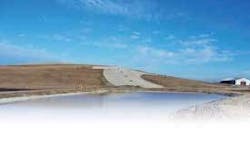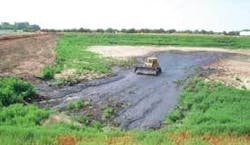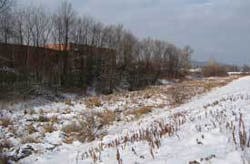Chemicals & Effluent Treatment: Natural Systems Provide Treatment and Community Benefits in Industrial Wetland Applications
by Mark Liner, PE
Treating industrial wastewater is a complex and often costly matter. Finding new methods that take a natural approach can enable companies to accomplish the environmental cleanup necessary - or avoid it altogether via advanced planning - and provide a potential asset to the community.
Treating Waste Naturally
The biological complexity of natural systems can be exploited to cope with the complexity of industrial waste streams - be they waste solid, air or water. Typically, these systems are mechanically simple, which translates to low operation and maintenance costs. The self-organizing nature of reed beds used as part of this technology makes them excellent choices for sludge dewatering and biofilters can be used to control odors from a complex matrix of volatile organics. It’s the use of engineered wetlands, however, that’s proving to be particularly flexible for use in industrial treatment.
With the chemical, physical and biological science of wetlands clearly understood, these systems are now tailored to virtually any required treatment parameter, which has resulted in widespread use. An added value is that these industrial wetlands can be designed as part of parks, golf courses, nature centers, trail networks, natural habitats and other green spaces where they become a central amenity to the community.
How Does It Work?
Industrial treatment wetlands with their simple mechanics, ease of operation, and low maintenance costs are becoming a leading choice for high quality treatment and remediation in a number of industries. Use of engineered wetlands for industrial wastewater treatment is not new. As experience with them continues to grow, though, the value they present beyond treatment is more appreciated.
Waste streams from airport deicing operations, concentrated feed lots, landfills and other contaminated sites are all candidates for this natural treatment complying with strict environmental regulation. What makes this approach even more enticing is the rate of acceptance by surrounding communities. This is due to the potential to integrate these industrial wetlands with community amenities such as recreational areas, nature centers, trail networks and natural habitats the residents can enjoy.
Making natural wetlands work in industrial applications depends on disciplined engineering practices. A wetland cell can be rigorously engineered to be a standalone treatment process or it can be coupled with others processes (such as lagoons) to augment performance. Taking away geometric uncertainty is first, closely followed by installation of impermeable liners and specific placement of influent and effluent points. With additional control of water levels, the system begins to behave more like an engineered reactor.
Subsurface wetlands are filled with gravel media, which is cleaned and sized to optimize hydraulic treatment. The loading rates of the wetlands are established so as to exploit bacterial growth while minimizing impacts on the subsurface hydraulics. An aeration system is installed at the bottom of the gravel, creating an aerobic zone within the wetland where water is recirculated to optimize treatment. Mulch is used for insulation. With these various control measures, what may seem to be a passive, uncontrollable technology actually has a process schematic similar to advanced sewage plants. This design flexibility allows for engineered wetlands to treat a wide spectrum of pollutants.
Following are examples of industrial wetland treatment in action:
Landfill Leachate Treatment
Due to the variable nature of landfill leachate, a treatment system must be able to receive and properly treat a range of parameters of varied concentrations. For this reason, a complete leachate system must include a number of unit processes that target removal of a certain group of parameters. Wetland treatment systems are used in concert with other processes to completely treat a full range of leachate parameters. In particular, they’re used for bacterial-remediated degradation of some of the more difficult to degrade organics. Aerobic and anaerobic zones can be engineered in the wetland to expedite degradation of xenobiotic compounds, i.e., chemicals foreign to a biological system. Subsurface wetlands with properly sized gravel media provide a stable surface for attached growth bacteria, which allows the bacteria to be resident in the wetland and acclimate to the variable load.
For the Anoka County Landfill, near Anoka, MN, a bioremediation system was designed for 288,000 gpd of leachate-contaminated groundwater. The design included eight 50,000 sq. ft. horizontal subsurface flow wetland treatment cells. To provide year-round treatment, the wetlands are insulated using energy balance design methods. Use of mulch as an insulation layer on subsurface wetlands has proven effective in permitting cold weather operations of wetlands. Forced bed aeration is also employed within the wetland cells to create alternating aerobic/anaerobic zones for degradation of complex organic compounds, including tetrahydrofuran - a clear, flammable liquid used as a solvent for natural and synthetic resins and in making nylon.
Detailed pilot work on an engineered wetland also has been conducted at the Jones County Landfill, in Anamosa, IA. The pilot is designed for remediation of up to 500 gpd of landfill leachate and is operated as a research facility by the University of Iowa Department of Civil and Environmental Engineering. Results from the pilot focus on the ability of the wetland to treat for ammonia during cold weather and dramatically illustrate the benefits of wetland aeration.
Agricultural Water Reuse
Farms have long been involved with cradle-to-cradle practices for managing wastes. Feed is produced from the field’s crops, animals eat the feed and generate manure, and manure is returned to the fields for crop production - a virtuous and sustainable nutrient cycle. Wastewater reuse also is commonly practiced. Christensen Farms of Sleepy Eye, MN, owns and operates a number of farms in the Midwest. Like many livestock production facilities, it reuses water at its facilities. To improve the quality of water for reuse, farm managers contracted with Jacques Whitford NAWE to create a wetland-based tertiary treatment system.
In the Christensen Farms wetland treatment system, earthen storage basins at four farms were re-engineered with tertiary treatment designed to reduce nitrogen levels in the reuse stream. Supernatant from the anaerobic lagoons is discharged to a pre-aeration cell for pretreatment. Afterward, flow is introduced into a free-water surface wetland designed to polish the water and provide a natural habitat for water fowl. Treated water is pumped from the wetlands and reused for barn washwater.
Refinery Groundwater Remediation
A former refinery operated by Sinclair Oil Company is currently home to The State University of New York’s Wellsville, NY, campus. As a result of the refinery’s practices, groundwater is contaminated with hydrocarbons, metals and chlorinated solvents. The land also lies adjacent to the Genesee River, which continuously receives the contaminated water.
Atlantic Richfield (ARCO), the current owner of the property, realized it needed a treatment system operable for at least 100 years with minimal maintenance requirements to clean up this site. It also wanted a treatment system designed to benefit and blend in with the Wellsville community. A passive wetland system was designed as a long-term solution to treat 280,000 gpd of contaminated groundwater.
The treatment system consists of a cascade aerator, sedimentation pond, parallel surface flow wetlands, parallel vertical flow limestone drains and sand drying beds for iron precipitate dewatering. The design also incorporates an upgrade of the adjacent rails-to-trails path, restoration of the adjacent river swale, and a 20-acre site plan using entirely native vegetation, including trees, shrubs, wildflowers, grasses and wetland plants. The site plan also incorporates a trail system with elevated boardwalks through the wetlands for observation. All of this, with minimal energy inputs, will become part of the landscape as it matures.
Airport Deicer Runoff Removal
Another innovative example of engineered wetlands for industrial wastewater treatment is use of subsurface, aerated gravel beds to treat stormwater contaminated with glycol from airport deicing operations. These wetlands are currently under design for Buffalo Niagara International Airport (BNIA). Below-grade beds are designed to sustain a resident, attached community of bacteria acclimated for the specific task of glycol removal. Stormwater is distributed uniformly over the beds and flows vertically through the gravel to a system of underdrains. Air is pumped to the beds through a network of aerating tubing. The bed is insulated on top with a layer of peat mulch, proven to be an important means to conserve heat.
Key to executing the design was the successful offsite treatability testing of propylene glycol-spiked stormwater from the airport. Pilot work at wetland test facilities was conducted to evaluate system performance and determine process kinetics. Results of the pilot-scale testing established that there was very good treatment (96-97% removal of target pollutants) at both high and low design basis temperatures.
At full build-out, the wetland will consist of eight cells on roughly 10 acres excavated from an existing open area near the airport’s main runway. At ground level, only a field of wetland grasses will be observable, growing from a “dry” mulch surface. Important aspects of the design are size of gravel used and porosity of the bed. Detailed analysis of biomass growth, storage and decay was undertaken to ensure the bed could seasonally accommodate the transient nature of the bacterial community.
Conclusion
To most, wetlands are a wet piece of land with plants. To an engineer, a wetland is a complex reactor that facilitates numerous chemical and biological reactions that can be exploited to remove pollutants. Environmental managers and engineers are looking for treatment solutions that work for the long haul. Designing systems to handle future flows with lower life cycle costs is often a key goal.
Engineered wetlands deliver on this goal and integrate the treatment necessity into the facility, even enhancing the site for plants, animals and people. Using state-of-the-art techniques, wetland engineers are able to create systems that effectively clean up the dirtiest of wastewaters - from landfill leachate to spent deicing fluid.
About the Author: A professional engineer, Mark O. Liner is senior engineer at Jacques Whitford NAWE Inc., of White Bear Lake, MN, near St. Paul. Over his 15-year career in the wastewater treatment arena, he has worked as a regulator at EPA’s Washington, DC, headquarters, as a process and equipment supplier for wastewater treatment systems, and as a design-build project manager for a 17.2 MGD sewage plant in Venezuela. Contact: 651-255-5046 or [email protected]




